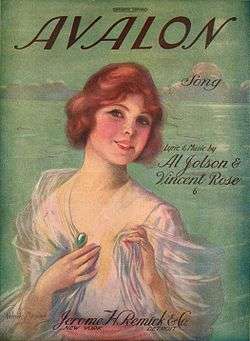Avalon (Al Jolson song)
| "Avalon" | |
|---|---|
 | |
| Song by Al Jolson | |
| Written | 1920 |
| Form | Jazz standard |
| Writer(s) | Al Jolson, Buddy DeSylva, Vincent Rose |
"Avalon" is a 1920 popular song written by Al Jolson, Buddy DeSylva and Vincent Rose referencing Avalon, California.[1] It was introduced by Jolson and interpolated in the musicals Sinbad and Bombo. Jolson's recording rose to number two on the charts in 1921.[1] The song was possibly written by Rose, but Jolson's popularity as a performer allowed him to claim composer co-credit.[1] Originally, only Rose and Jolson were credited, and DeSylva's name was added later.[1]
A popular jazz standard, the song has been recorded by many artists, including Cab Calloway (1934), Coleman Hawkins (1935) and Eddie Durham (1936). The Benny Goodman Quartet played the song in their famous 1938 Carnegie Hall concert.[1] The song was included in the biographical films The Jolson Story (1946) and The Benny Goodman Story (1956), and is also being noodled by Sam (Dooley Wilson) at the piano right before he plays As Time Goes By in the movie Casablanca (1942).[2] The tune remains popular in the gypsy jazz repertoire, having been performed by Wawau Adler and others.
The tune's opening melody resembles a part of Giacomo Puccini's aria E lucevan le stelle, from the opera Tosca, but in the major key.[1] Puccini's publishers sued the song's composers in 1921 for use of the melody, and were awarded $25,000 and all subsequent royalties of the song by the court.[1]
Renditions
- Charles W. Harrison (1920)
- Art Hickman's Orchestra (1921)
- Harry Raderman's Jazz Orchestra (1921)
- Red Nichols and His Five Pennies (25 February 1928 [or 27 February 1928, according to some sources])
- George Monkhouse and his Cambridge University Quinquaginta Ramblers (12 March 1930)
- Spike Hughes and his Dance Orchestra (23 May 1930)
- Joel Shaw and his Orchestra (August 1932)
- Billy Cotton and his Band (21 July 1933)
- Casa Loma Orchestra (16 August 1934)
- Cab Calloway and his Orchestra (4 September 1934)
- Scott Wood and his Six Swingers (18 December 1934; 1 September 1936)
- Joe Venuti and his Orchestra (26 December 1934)
- KXYZ Novelty Band (29 January 1935)
- Coleman Hawkins (2 March 1935)
- Quintette of the Hot Club of France (July 1935)
- Jimmie Lunceford and his Orchestra (30 September 1935)
- Harry Roy and his Orchestra (8 November 1935)
- Val Rosing and his Swing Stars (18 November 1935)
- Ballyhooligans (7 July 1936)
- Benny Goodman Quartet (29 June 1937; 28 September 1937; 16 January 1938)
- Joe Daniels and his Hotshots (28 September 1937)
- Alix Combelle et son Orchestre (4 October 1937)
- Harry James and his Orchestra (13 July 1939; 8 November 1939)
- Willie Lewis and his Negro Band (27 June 1941)[3]
- Lou Donaldson and guest musicians on the album Gravy Train (1961)
- Harry Connick, Jr. on the album 20 (1988)
- Natalie Cole on the album Unforgettable... with Love (1991)
See also
Notes
- 1 2 3 4 5 6 7 Tyle, Chris. "Avalon (1920)". JazzStandards.com. Retrieved 2009-08-19.
- ↑ Jasen, David A. (2002). A Century of American Popular Music: 2000 Best-Loved and Remembered Songs (1899-1999). Taylor & Francis. p. 14. ISBN 0-415-93700-0.
- ↑ Crawford, Richard; Magee, Jeffrey (1992). Jazz Standards on Record, 1900–1942: A Core Repertory. Center for Black Music Rsrch. pp. 6–7. ISBN 0-929911-03-2.